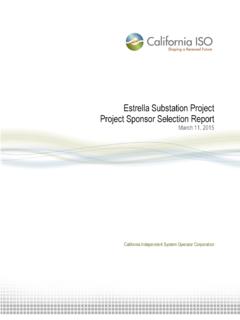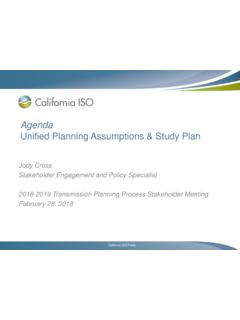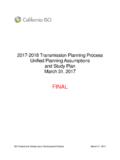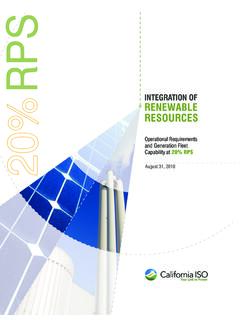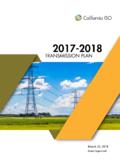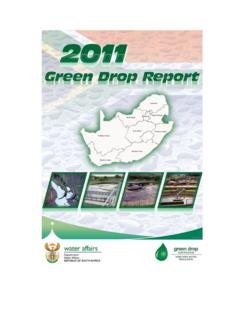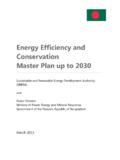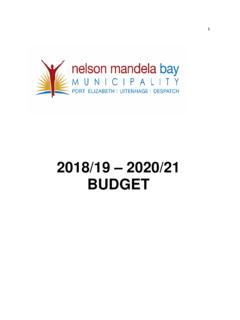Transcription of CALIFORNIA PUBLIC UTILITIES COMMISSION CALIFORNIA …
1 STATE OF CALIFORNIA EDMUND G. BROWN JR., Governor CALIFORNIA PUBLIC UTILITIES COMMISSION 505 VAN NESS AVENUE SAN FRANCISCO, CA 94102-3296 CALIFORNIA energy COMMISSION 1516 NINTH STREET SACRAMENTO, CA 95814-5512 February 15, 2018 Mr. Steve Berberich President and Chief Executive Officer CALIFORNIA Independent system Operator Box 639014 Folsom, CA 95763 Transmitted electronically Re: Request for Sensitivity Case in the CALIFORNIA Independent system Operator 2018-2019 Transmission Planning Process Increased Capabilities for Transfers of Low Carbon Electricity between the Pacific Northwest and CALIFORNIA . Dear Mr. Berberich: CALIFORNIA Governor Edmund G. Brown, Jr. has directed me, Chair Robert B. Weisenmiller, to develop a plan that would allow for the shut down of the Aliso Canyon Natural Gas Storage facility (Aliso Canyon) in ten years, which I conveyed to President Michael Picker, CALIFORNIA PUBLIC UTILITIES COMMISSION (CPUC) and cosigner of this letter, in a letter dated July 19, 2017.
2 Implementing a plan and accomplishing the timely phase-out, while maintaining system reliability (gas and electric), will require a concerted effort on the part of the UTILITIES , energy COMMISSION , CPUC, and CALIFORNIA Independent system Operator ( CALIFORNIA ISO). The CPUC has already opened up an Order Instituting Rulemaking (OIR) looking at the medium term closure of the Aliso Canyon. In January 2018, the CALIFORNIA Center for Science and Technology (CCST) released their legislatively directed report detailing their review of critical parameters including necessity for storage, health and environment risks and changing impacts of CALIFORNIA climate Phasing out Aliso Canyon usage and potential impacts on the gas-fired generation fleet need to be considered from the perspective of reliability of electricity supply to southern CALIFORNIA more generally and the Los Angeles Basin in particular, as well as the role those resources play in providing adequate system capacity and flexibility overall.
3 Study efforts have begun both under the CPUC s OIR as well as the CALIFORNIA ISO s own study processes. However, we are seeking your support in providing focus on one area in particular: transmission. As it was identified in the CCST study, expanded transmission capability is an important option available to us. Clearly, increasing the transfer of low-carbon supplies to and from the Northwest 1 CALIFORNIA Council on Science and Technology, Long-Term Viability of Underground Natural Gas Storage in CALIFORNIA , January 2018, Topics reviewed were: 1) What risks do CALIFORNIA s underground gas storage facilities pose to health, safety, environment and infrastructure? 2) Does CALIFORNIA need underground gas storage to provide for energy reliability through 2020?
4 3) How will implementation of CALIFORNIA s climate policies change the need for underground gas storage in the future? Mr. Steve Berberich Page 2 February 15, 2018 can be one of the multiple puzzle pieces that we must examine to build a cumulative phase out strategy. Toward this end, we are requesting a specific sensitivity case be included in the 2018-2019 CALIFORNIA ISO transmission planning process (TPP). It is time-critical that we act now to evaluate key options to increase transfer ratings of the AC and DC Intertie and assess what role these systems can play in displacing generation whose reliability is tied to Aliso Canyon. The insights gained from the sensitivity can be used to inform a broader assessment of Aliso Canyon Phase-Out options that would include, additional energy efficiency, demand response, storage, as well as overall transmission project additions if any emerge in this TPP.
5 A synopsis of the primary elements of the sensitivity we are requesting Increased Capabilities for Transfers of Carbon-Free Electricity between the Pacific Northwest and CALIFORNIA is provided later in this letter; in short, it would include considerations such as: Increasing the current dynamic transfer capability limits from 400 MW to some substantially higher credible level supported by engineering analyses; Automating of manual controls for essential Bonneville Power Administration (BPA) facilities, primarily in support of sub-hourly scheduling of the Pacific DC Intertie; Potentially increasing the capacity rating of the Pacific AC and DC Interties, as well as consideration of intra- CALIFORNIA paths that could otherwise be limiting; Assigning some resource adequacy (RA) value to hydro generation imports that could be shaped through unused storage capacity potentially available in the Northwest.
6 CALIFORNIA & Northwest Diversity Opportunities Traditional and Emerging The rationale for pursuing this sensitivity is the hope it can illuminate potential benefits (and costs) of building on the long history of exchange between the Pacific Northwest and CALIFORNIA entities. This has become even more urgent with the potential phase-out of Aliso Canyon looming large, and the apparently increasing reliance on these paths. As observed over this past summer, the loadings on the Pacific AC and DC Interties have increased in part to meet demand for some Aliso Canyon-dependent replacement generation. Moreover, rapidly evolving markets and generation resource availability only increase the benefits as highlighted by: Emerging initiatives to enhance the energy Imbalance Market and potential day-ahead market opportunities; Continuing and increasing goals for reducing the greenhouse gas (GHG) emission footprint; Increasing need for and value of flexible system with ramping generation for reliability; Changing dynamics of surplus renewable sales during certain hours and periods of the year; Pursuing use of low-cost generation resources (new construction or existing system diversity).
7 Goals that CALIFORNIA and the Pacific Northwest BPA in particular - have in common that can be served by a policy evaluation include: Making best use of existing infrastructure and corridors; Evaluating opportunities to enhance transfer capability on Pacific AC and DC Interties; Mr. Steve Berberich Page 3 February 15, 2018 Assessing potential for optimizing the British Columbia Hydro and BPA hydro systems to allow storage of BPA surplus non-firm energy in British Columbia facilities and thus create preferred timing and shaping of market products. Synopsis: Primary Elements of the Increased Capabilities Sensitivity Case Elliot Mainzer, Administrator of BPA, has indicated his support for a team effort to illuminate these potential capability increases. Details of the sensitivity case will need to be developed through staff-to-staff discussions, but four elements of primary interest now under discussion with BPA are summarized as follows: Increasing dynamic transfer capability limits beyond 400 MW.
8 Conduct engineering analyses to determine an upper limit on dynamic transfer capability from the BPA system . Reflect BPA Reliability Action Scheme (RAS) automation efforts and the relationships to voltage variability and stability concerns within both the BPA system and the broader Northwest grid. Automating manual controls on key BPA infrastructure. Assume that within a five-year horizon BPA (at Celilo) and operators at Sylmar deploy necessary upgrades to the automatic generation control and energy Management Systems (EMS) operating at the converter stations to facilitate intra-hour scheduling on the Pacific DC Intertie and perform sensitivity analyses to assess the impacts to Northwest hydro energy transfer capability from a reliability and ramping perspective to support the goal of closing Aliso Canyon.
9 Increasing rated capacity of AC Intertie and Pacific DC Intertie. Explore the costs and benefits of potential increases to AC and DC intertie capacity with the Pacific Northwest, considering a range of options as well as assessing downstream impacts to transmission within CALIFORNIA . Assigning some RA value to firm zero-carbon imports or transfers. Develop a bounding case that assumes maximal utilization of existing infrastructure investments supporting energy Imbalance Market operations of participating entities in the Northwest, as well as the integration of synchro-phasor data into control room operations. This case will inform further study and explore the maximum annual expected Northwest hydro import capability of the CALIFORNIA ISO grid to estimate an upper bound on avoided GHG emissions assuming that RA/RPS counting criteria are not limiting.
10 These elements are designed in part to support the CALIFORNIA ISO pursuit of 15 minute scheduling with BPA, and to affirm that although seasonal swaps can be an accounting hurdle, they could ultimately reduce coal in Northwest in the winter, reduce CALIFORNIA solar curtailment during the day, and help with peak during the spring and winter when there is excess hydroelectricity from the Northwest. Concluding Thoughts Elliot Mainzer has indicated his support for this effort to illuminate these potential capability increases. Toward this end, he has offered his staff s assistance to provide inputs that could be a useful complement to CALIFORNIA activities under the TPP. There clearly is appreciable technical team talent across the energy COMMISSION , the CPUC, BPA, and CALIFORNIA ISO. In close cooperation with the transmission system owners, we should be well positioned to ensure thoughtful development of the sensitivity parameters.


